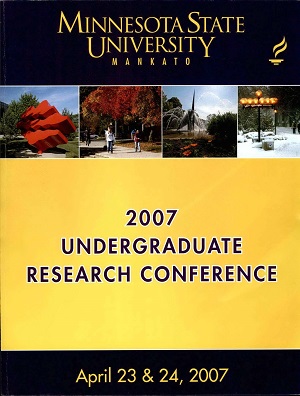Gas Washing Analysis: Revealing Profitable Oil Reserves
Location
CSU 253/4/5
Start Date
23-4-2007 1:00 PM
End Date
23-4-2007 3:00 PM
Student's Major
Chemistry and Geology
Student's College
Science, Engineering and Technology
Mentor's Name
Steven Losh
Mentor's Department
Chemistry and Geology
Mentor's College
Science, Engineering and Technology
Second Mentor's Name
Daniel Swart
Second Mentor's Department
Chemistry and Geology
Second Mentor's College
Science, Engineering and Technology
Description
Crude oil slowly floats up through sediment below the earth's surface and is trapped in reservoirs, while natural gas ascends at a faster rate. When mixed together, natural gas dissolves into crude oil. When more natural gas is present than can be dissolved, it escapes from the crude oil, taking with it some of the lighter hydrocarbon compounds from the crude oil. This stripping of hydrocarbons is known as gas washing and is the focus of this research project. We have developed a program for the gas chromatograph here at MSU, Mankato, which has enabled us to analyze many different oil samples taken from a variety of oil wells offshore Louisiana in the Gulf of Mexico. This is the first time oil analysis of the type has been done on this campus. Previous work along a single transect showed that gas washing typically decreases in the offshore direction. We have analyzed samples from a number of oil fields along a parallel transect about 50 miles east of the first one to test the hypothesis that gas washing generally decreases with distance from the shoreline. We have interpreted the analytical results and have come up with some preliminary conclusions as to the trend of gas washing over a large area, as well as some thoughts about what controls the extent of gas washing based on the data. Finally, we have done some calculations concerning the economic significance of this process that could be of use to industry exploring in this region.
Gas Washing Analysis: Revealing Profitable Oil Reserves
CSU 253/4/5
Crude oil slowly floats up through sediment below the earth's surface and is trapped in reservoirs, while natural gas ascends at a faster rate. When mixed together, natural gas dissolves into crude oil. When more natural gas is present than can be dissolved, it escapes from the crude oil, taking with it some of the lighter hydrocarbon compounds from the crude oil. This stripping of hydrocarbons is known as gas washing and is the focus of this research project. We have developed a program for the gas chromatograph here at MSU, Mankato, which has enabled us to analyze many different oil samples taken from a variety of oil wells offshore Louisiana in the Gulf of Mexico. This is the first time oil analysis of the type has been done on this campus. Previous work along a single transect showed that gas washing typically decreases in the offshore direction. We have analyzed samples from a number of oil fields along a parallel transect about 50 miles east of the first one to test the hypothesis that gas washing generally decreases with distance from the shoreline. We have interpreted the analytical results and have come up with some preliminary conclusions as to the trend of gas washing over a large area, as well as some thoughts about what controls the extent of gas washing based on the data. Finally, we have done some calculations concerning the economic significance of this process that could be of use to industry exploring in this region.
Recommended Citation
Dickinson, Andrew. "Gas Washing Analysis: Revealing Profitable Oil Reserves." Undergraduate Research Symposium, Mankato, MN, April 23, 2007.
https://cornerstone.lib.mnsu.edu/urs/2007/poster-session-B/8



